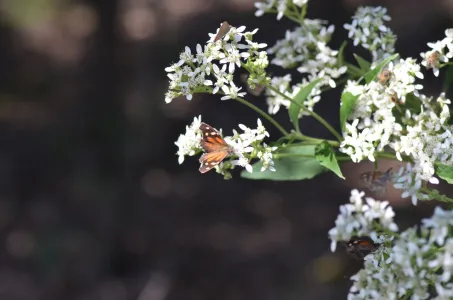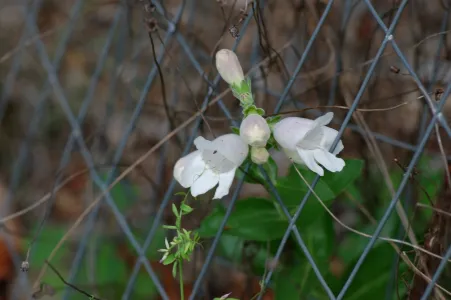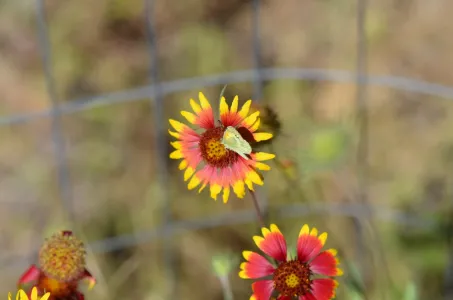By Delmar Cain
My neighbor does not like frostweed. She has instructed that it should be chopped down or mowed when it is found. I don’t know whether she objects to its height, its ability to spread, that it is perennial or to the fact that it must be a weed, given its common name. That frostweed (Verbesina virginica) is a good source of nectar for migrating monarchs is a point to be considered. But for my neighbor it is still a weed and has an early date with a mower, if found in her field of view.

What is a weed? My old 1984 “Webster’s Ninth New Collegiate Dictionary” defines a weed as (1) “a plant that is not valued where it is growing and is usually of rank growth; esp: one that tends to overgrow or choke out more desirable plants.” Like other things related to real estate being a weed partly has to do with location, location, location.
I am made aware of the fact that location is important when occasionally I find myself on a website sponsored by Texas A & M University (or one of the TAMUS agencies), which lists “Weeds of Field Crops and Pastures” (http://twig.tamu.edu/keyindex.htm). The list includes some invasive plants such as Malta star thistle, Kudzu and Musk thistle, that we would all agree have little value, at least in the United States.
But the first time I ran across this website, I wondered why anyone would want to classify Wild foxglove (Penstemon digitalis), Indian blanket (Gaillardia pulchella) and even Golden Tickseed (Coreopsis tinctoria) as weeds. These are wildflowers and I collect the seeds of these plants to try to get them to grow. These are not weeds in my yard.

However the list is meant for those who have field crops and pastures. I know from experience that Bermudagrass was not very welcome in the same row with my Dad’s tomato plants. And I still have the digging fork that he had me use to try to get that pesky, deep-rooted pest out of his sight before he planted. (Whoever brought Bermudagrass to the sandy fields of East Texas would have also “put B’rer Rabbit in the briar patch”.)
But I have this nagging thought that keeps running through my head. Part of what makes a weed a weed is that some human wants to grow something else in that spot without interference. And it really doesn’t matter that the weed was there first. If it doesn’t fit in with the newest and improved plan, it is probably about to be history unless it can find a way to “lay low”.
In the Twentieth and Twenty-First Century, we humans have had the ability to change the plan for large areas of land for many years in the future. I am reminded of the ranchers in South Texas, who used large bulldozers and chains to clear thousands of acres of brush country for improved (generally read imported) pasture grasses, the then newest and most improved plan.

We will never know if in that area there were rare “weeds”, or rare butterflies, or rare insects, or rare toads or rare lizards. Some may not care. We do know one thing that did become less plentiful with that newest and improved plan. The wildlife and more particularly the quail began to lay low and almost became history. In South Texas that was an attention-getter.
Now the newest and most improved plan is to restore the native grasses or in other words take them off the weed list. But since baby quail need insects and caterpillars to make it to adulthood, some of those other herbs and shrubs, host plants for the moths, beetles and butterflies, better be taken off the weed list also. One man’s weed is some insect’s buffet.
Whether it is for 1 million acres or for a 100 by 100 feet lot it usually takes a fraction of the time and costs less money to remove what is growing there than to restore what should be growing there. Someone would make a lot of money if he/she could develop a phone app that would give us the whole picture instead of a laser view.
In the interest of full disclosure I should give you the second part of the definition of “weed” from my old new collegiate dictionary. It is: (2) “an obnoxious growth, thing or person.” I will leave for another day a discussion on who gets to vote on which of us or how many of us have earned the weed label. But one thing is for certain. At every location where I have ever found one, a sandbur meets or exceeds every requirement of being called a weed.
For anyone interested observing National Moth Week July 20-28, there will be a Moth Night at the Cibolo Nature Center on Friday, July 26th beginning at 8:00 PM until we get tired. There will be a short presentation on moths and identification sources, a walk to beat and look for caterpillars, and different types of lights to see which moths might find them attractive. If you come, bring your camera and you might find it helpful to bring a flashlight. For updates, check the Cibolo Nature Center Website.


